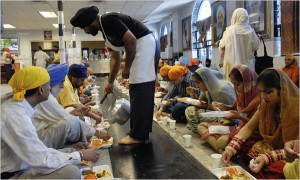
Since 9/11, Sikh advocates and community members have been proactive about providing training for law enforcement officers to educate them about our religion and articles of faith and to foster positive relations between local police and Sikhs. My feelings about the role of the police in our communities aside, the Village Voice is reporting that New York City cops have been doing some learning about the Muslim community lately. But not the kind of learning that SALDEF and other Sikh organizations have been facilitating across the country.
At a recent counter-terrorism training, NYPD officers were shown a full-length, Muslim-bashing film called The Third Jihad. According to the Village Voice, the film “is 72 minutes of gruesome footage of bombing carnage, frenzied crowds, burning American flags, flaming churches, and seething mullahs. All of this is sandwiched between a collection of somber talking heads informing us that, while we were sleeping, the international Islamist Jihad that wrought these horrors has set up shop here and is quietly going about its deadly business.”
During the film, the narrator says, “Americans are being told that most of the mainstream Muslim groups are moderate when in fact, if you look a little closer, you’ll see a very different reality. One of their primary tactics is deception.”
Guest blogged by Hunny Singh
Recently I went home to the East Coast and had som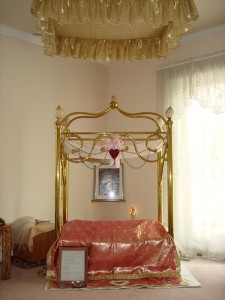 e inspirational time with my family. While snowy conditions prevailed outside, inside the house, a pizza soon to be shared joined a confused and yet open love for a dance. I had an interaction with my mother that got me wanting to share with y’all. Here’s the story…
e inspirational time with my family. While snowy conditions prevailed outside, inside the house, a pizza soon to be shared joined a confused and yet open love for a dance. I had an interaction with my mother that got me wanting to share with y’all. Here’s the story…
As Ma Ji pokes her head out from behind the curtains, she pauses ever so slightly, and says:
“Remember the Guru with every passing day.”
She returns to being with the Sri Guru Granth Sahib, glasses on, focused gaze settling back in. Especially endearing to me are her engaged brows, lifted eyelashes, and soft thought.
In the dim light, I see the reflections of the Guru’s words bringing meaning upon her eyes.
Yup, I’ve seen that look before so many times.
She is in Baba Ji’s room.
I don’t remember when the Baba Ji’s* room became a part of our house and our lives, but I do remember it always being there. That’s the only name I have ever known for the room. I think this room is something that many Sikh folks share, in some way or form–a special intimate space.
Today marks the 82nd birthday of Reverend Dr. Martin Luther King, Jr. Most of us learn about Dr. King’s influential role in the Black Civil Rights Movement in the United States, and have heard his “I have a dream” speech. But less do we hear about his opposition to the Vietnam War and his revolutionary calls for an end to U.S. militarism, calling his government “the greatest purveyor of violence in the world today.” As a man who was deeply driven by spiritual motives who used religious institutions to organize millions, Dr. King is a constant inspiration to me, and I hope to other Sikhs.
Check out the below video to hear his powerful and righteous “Beyond Vietnam” speech from April 4, 1967, exactly one year before he was murdered.
I am convinced that if we are to get on the right side of the world revolution, we as a nation must undergo a radical revolution of values. We must rapidly begin…the shift from a thing-oriented society to a person-oriented society. When machines and computers, profit motives and property rights, are considered more important than people, the giant triplets of racism, extreme materialism, and militarism are incapable of being conquered.
I love food. I love to cook. I love to gather with friends, community, and sangat and share a meal together.
Because food it our most primal need and our common bond to the earth and one another, it can ground us as we stretch ourselves to draw in all the interlaced threads—so we can weave a whole, meaningful picture for ourselves. I still believe food has this unique power. With food as our starting point, we can choose to meet people and to encounter events so powerful that they jar us out of our ordinary way of seeing the world, and open us to new, uplifting, and empowering possibilities. – Frances Moore Lappe and Anna Lappe, from Hopes Edge: The Next Diet for a Small Planet
The Sikh institution of langar has always been something near and dear to me, partially because of my borderline obsession with food, but also because it really gets to the heart of Sikhi. The practice of langar, our free community kitchen, was started some 500 years ago by Guru Nanak to meet a basic human need – eating – and to create a space for community-building that reflected the Guru’s radical vision of equality. Rules about food preparation and eating were (and still are) one of the central ways that caste oppression was enforced. Langar turned this all on its head. With everyone sitting together on the same level (on the floor) and eating the same simple food, which was prepared by people from all caste backgrounds, langar was nothing short of a revolutionary accomplishment.
It is with this lens that I want to discuss the food of langar itself.
Guest blogged by Navdeep Singh Dhillon
The reformist, humanitarian wife of Franklin D. Roosevelt (32nd President of the United States) – and “first lady of the world” – Eleanor Roosevelt once famously said, “Great minds discuss ideas, average minds discuss events, small minds discuss people.”
Over the past few years, I have become quite disheartened over the state of the discussion of 1984, based on conversations I’ve had with seemingly well-educated people and what I’ve seen in the media. The record seems to be stuck on “events” and has barely moved an inch into the arena of “ideas.”
A few months ago, an entire issue of India Abroad was devoted to 1984 and I was initially interested to read it. But after reading just a few paragraphs, I realized it was the same ole, same ole: a recap of the events by people who were narrating their experiences during 1984 and shortly thereafter. The experiences themselves were very vividly told, but the articles didn’t seem to have any real purpose, other than to keep the conversation within 1984.
It is obviously extremely important to know the facts, the history, the events that took place, the backdrop, and of course the people involved. But there should be a “now what?” aspect put into place that involves something more than mentioning the names of Jagdish Tytler and Sajjan Kumar, rehashing the timeline, the people involved, holding a few film screenings and handing out fliers. Shouldn’t there?
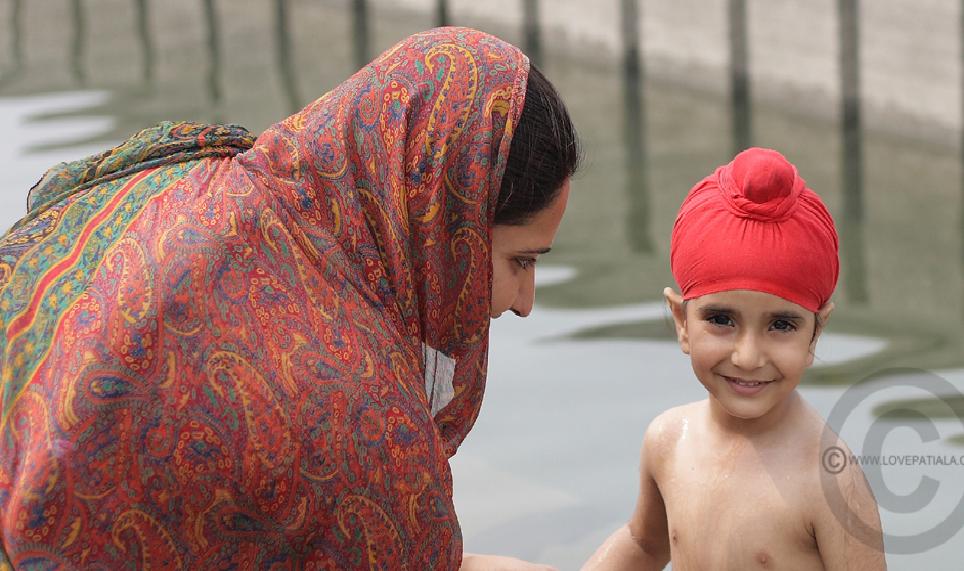 There was an interesting whimsical read in the Wall Street Journal by a Yale Law Professor, titled “Why Chinese Mothers Are Superior” The article states that the ethnicity has some possible substitutions, so I indulged, as its main opposition is suppose to be something called “Western.”
There was an interesting whimsical read in the Wall Street Journal by a Yale Law Professor, titled “Why Chinese Mothers Are Superior” The article states that the ethnicity has some possible substitutions, so I indulged, as its main opposition is suppose to be something called “Western.”
Here are some of its insights:
A lot of people wonder how Chinese parents raise such stereotypically successful kids. They wonder what these parents do to produce so many math whizzes and music prodigies, what it’s like inside the family, and whether they could do it too. Well, I can tell them, because I’ve done it. Here are some things my daughters, Sophia and Louisa, were never allowed to do:
- attend a sleepover
- have a playdate
- be in a school play
- complain about not being in a school play
- watch TV or play computer games
- choose their own extracurricular activities
- get any grade less than an A
- not be the No. 1 student in every subject except gym and drama
- play any instrument other than the piano or violin
- not play the piano or violin.
For more discussion, click below the fold
Guest blogged by Ajaib Kaur
Amrita (Ami) Kaur Dang’s sound often is described as a “blend” of the classical (traditional) and the experimental (non-traditional). Tossing together her North Indian vocal training with impressive sitar skills, she playfully builds collages of inquiry. Also creating the feel of a fireside gathering for trans-national, digital, post-modern sound to question everything. While a blend or an intersection might be an easier way to describe Amrita’s style to a western audience, I find her sound to be an embodiment of the everyday Sikh experience.
Click here to listen to her track “Strange Community.”
The mesmerizing loops and samples, of each track on Amrita’s full length debut album “Hukam” capture the repetitive daily dance we each participate in. Within each track there are varying sensibilities of bargaining, or even resignation, but often vigor and passion that all listeners can relate to.
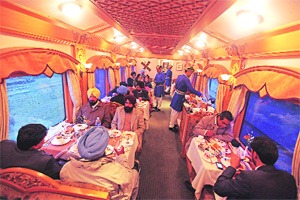 A luxury train, costing about $10,000 per passenger, and traveling to the five takhts throughout India has begun it’s journey. The nine-day trip will begin in New Delhi and will stop at Keshgarh Sahib, the Akal Takht, Damdama Sahib, Hazoor Sahib and Patna Sahib.
A luxury train, costing about $10,000 per passenger, and traveling to the five takhts throughout India has begun it’s journey. The nine-day trip will begin in New Delhi and will stop at Keshgarh Sahib, the Akal Takht, Damdama Sahib, Hazoor Sahib and Patna Sahib.
The 21-coach train includes two presidential suites, five-star rooms, a spa, a salon, gym, two restaurants, a conference hall and a business center! [link] There are currently 88 passengers on board from both India and abroad including the US, Canada, the UK, Germany and France. The trip is being managed by the Taj group of hotels.
It sounds like the trip is not necessarily directed towards Sikhs and is not simply a “pilgrimage” but apparently will include additional stops in Rajasthan for sightseeing. One article notes that,
Different legs of the journey will have performances by traditional artists onboard. “Kirtans” (holy songs of Sikhs) by Sikh hymn singers called Raagis will also be an attraction.
The next trip is planned for March 2011 with an ultimate goal of doing four trips a year. What are your thoughts – would you pay $10,000 for a trip like this?
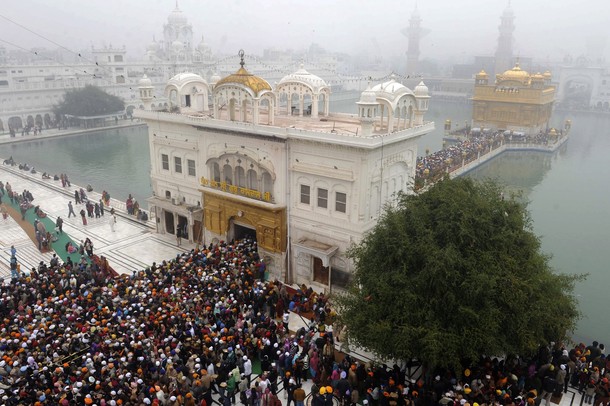
New Years Day at the Darbar Sahib
From all of us here at The Langar Hall, we’d like to wish all our readers a very happy new year! As you may have noticed, our posts have been intermittent lately. This is a result of committment changes and transitions occuring in the lives of many of our bloggers. As is the case in all communities, change is inevitable, and TLH is no exception.
While the basic premise of this site will remain the same (see more here), 2011 is bringing us some fresh new voices and exciting changes. You can expect to see more posts by a number of guest bloggers (Mehmaan) and by February several new permanent bloggers. We are excited about the new writers who will be contributing to TLH this year, and we continue to encourage readers who are interested in participating in this process to send a note to admin[at]thelangarhall[dot]com.
Also, as previously mentioned, we hope TLH can be a place where Sikhs all over North America (and hopefully even beyond!) can find out about Sikhi related events happening in their areas. We are still working out the technology to make this happen, but we hope to get an events calendar up and running early this year.
Let the conversations begin,
Fateh!
Last week I attended a diwan of about 50 people on a Thursday night on the east side of Manhattan, in New York City. The Manhattan Sikh Association (MSA) has been organizing monthly diwans in NYC for years now in apartment buildings and other temporary locations, but recently the group opened up a permanent space on East 30th street and Park avenue in Manhattan, making it the island of 2 million inhabitants’ first gurdwara.
I’ve always enjoyed attending the intimate MSA diwans, which tend to attract a lot of young Sikh professionals who live or work in Manhattan and the surrounding areas. Even the New York Times was intrigued by MSA and did a story on them last year. As I sat in their new space last Thursday, I felt calm and at peace, no one was yelling at me about the latest gurdwara politics**, and my peers, many of whom were second generation Americans like myself, were the ones doing kirtan, leading Rehras Sahib and Ardas, and in short, running the show. One young Sikh did a brief and conversational viakhia (commentary) in English of his shabad before he started singing. I thought to myself, this is a spiritual space.
Sadly, a spiritual space for sangat to come together, reflect and grow is a far stretch from what most gurdwaras I’ve attended in North America feel like.
Guest blogged by Ajaib Kaur
I saw this video recently on a photography project inspired by Rana Singh Sodhi and the loss of his brother after 9/11 to a bias-motivated crime, or ‘ hate crime’. The project aims to capture photographs of one child from every country in the world, residing right here in New York.
I was inspired to do this project in 2003, when I was driving across the United States and I stopped at a gas station in Mesa, Arizona and I met this gentleman named Rana. A couple days after 9/11 Rana’s brother was planting a tree in front of a family owned gas station, and someone drove by, saw a Sikh who was like Rana wearing a turbanand a beard and shot him.
He further reflects on the characteristics of the children he captures:
What I was capturing was not the ethnicity of the child or the fact that they were a New Yorker, but a very specific emotion about that person, so that it represents a spectrum of emotion that we all know.
The piece is an interesting take on combating bias in one of the most ethnically diverse cities in the world. Since the U.S. Census has found that the next generation of Americans will be considerably more diverse than the previous generations with more immigrant communities making their way out to ethnic enclaves in the suburbs [link], and since the ethnic makeup is in constant flux across spaces and neighborhoods [link], projects on how mixed communities can relate to each other in these spaces are needed.
The project is also an example of how Sikhs can engage in new media and platforms where Sikh representation is in dialogue with other ethnic and religious communities, rather than in isolation.
Thank you Danny Goldfield, for your contribution.
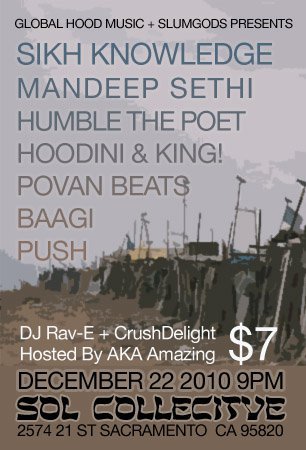 So, in the new year we’ll be bringing about some changes to TLH and we hope that one of these changes will be a better way of highlighting events happening in and around North America.
So, in the new year we’ll be bringing about some changes to TLH and we hope that one of these changes will be a better way of highlighting events happening in and around North America.
In the meantime, for our California Langar Hall family, you can catch Sikh Knowledge + Mandeep Sethi + Humble the Poet + Hoodini & King! + Povan Beats + Baagi + Push at Sol Collective on December 22nd starting at 9pm. The event will be hosted by the very funny AKA Amazing.
Please view the facebook event page here and a video below highlighting many of these artists. The video is filmed by the very talented, Digitology.
 The Chair of the US House of Representatives Foreign Relations Committee, Rep. Howard Berman, is trying to push a resolution through Congress today “condemning unilateral declarations of a Palestinian state.”
The Chair of the US House of Representatives Foreign Relations Committee, Rep. Howard Berman, is trying to push a resolution through Congress today “condemning unilateral declarations of a Palestinian state.”
The United Nations has long recognized the sovereignty of the Palestinian people in the Occupied Palestinian Territory, including East Jerusalem as a matter of international law. Since 1975 the UN has recommended that the Palestinian people be able “to exercise their inalienable rights to self-determination, national independence and sovereignty; and to return to their homes and property.”
There is growing consensus around the rest of the world in support of Palestinian sovereignty and statehood, yet two countries stand in the way: Israel and its fiscal sponsor, the United States.
I just received notice from the US Campaign to End the Occupation about this horrifying resolution that will be voted on today.
I recently got turned on to this band BlackMahal from the San Francisco area, fronted by the legendary dholi Ustad Lal Singh Bhatti.
According to the band’s website, “BlackMahal is steeped in Old California, a Punjabi-American experience that started in the 1890s when the first Punjabi-Americans settled in the Great West and forged a new identity combining elements of Mexican and African-American influence. BlackMahal also represents the new California feel: hippy hybrid hip-hop and hysterical hi-jinks. ”
The band also features the talented and righteous Sikh rapper Mandeep Sethi.
For those of you who are following the Sikh hip-hop scene, Navdeep Singh Dhillon’s blog has a good overview of each of the musicians who’ll be in attendance at the upcoming Lahir 2010: Move the Movement event in New Jersey. Here’s an excerpt about one of the rappers whose name means Rebel,
Baagi Gunjiv is one of the very few rappers out there who raps in Punjabi. The only other one that I can think of is Bohemia, and his songs are all about “thug life” in Oakland and Sacramento. Not that there’s anything wrong with that =) So just the fact that he is rapping in Punjabi and rapping about social issues like farmer suicides, droughts, and 1984, is hopeful, but he doesn’t really have very many songs out there to draw a conclusion from. The only other one I have heard, “Baagi di Vaari” was produced by Sikh Knowledge so it sounds very professional, but content-wise, it is a bit vapid. In his defense, the chorus “Bubbe noon kanna, te Gugge noon bihari” which details the two punctuation marks required to write his name in Gurmukhi, falls in line with any other debut rapper. “What’s my name? Snoop Doggy Dog.” “I’m Bushwick Bill, but you can call me Richard.” “Vanilla Ice Ice Baby,” “Hi, my name is. Slim Shady.”
So I am looking to forward to seeing what else he comes up with and remain optimistic that he will be the breath of fresh air for Punjabi music, both in Punjab and overseas so we can move more towards heightening the consciousness of the masses rather than songs like Diljit’s deep lyrics: “Chandigarh vich kudi milli, chocolate vargi” which I can’t even bring myself to translate. [link]

Though Sikhs have settled all around the world, roughly 20 million Sikhs still reside in Punjab. There, and elsewhere, Sikhs are facing serious problems including, but not limited to: farmer suicide, female infanticide, drugs and alcohol abuse, domestic violence, economic disasters, disease, poverty, illiteracy, and much more. [Lahir Press Release]
Many of my most recent posts have been about upcoming events happening in the Sikh Community. I think this is a positive sign – that rather than idly discussing and debating issues that inflict our panth, we are actually doing something about it! I would like to highlight two upcoming events occurring in North America. These platforms will bring together talented youth to raise awareness and by doing so, will aim to address important issues within our community. Please support these endeavors so that we can continue to move our panth in the right direction.
Lahir: Save Punjab. Save Ourselves | New Jersey | November 20th | 6pm
Lahir: Move the Movement 2010 is a night of spoken word, poetry, music, and the arts. Artists will include G.N.E., Hoodini, Mandeep Sethi, Gunjiv “Baagi” Singh, MC G-Singh and Humble the Poet. The event will kickoff the movement to respect and protect Punjab by donating all profits to the Baba Nanak Education Society (BNES), an organization which provides humanitarian assistance in rural Punjab to next of kin of suicide victims. These are families with small children left completely destitute by the death of bread-winners and have been neglected by the government. A donation of approximately $350 can help support one family for a year. For more information, visit the facebook page.
This morning the Sikh Coalition, SALDEF and United Sikhs issued Alerts advising the community that Sikhs should now expect turbans to be searched 100% of the time at American airports. The alert has been copied below so that community members are aware of this prior to arriving at airports around the country.
(Washington, DC) October 22, 2010 – Earlier this month, Transportation Security Administration (TSA) officials told representatives of the Sikh Coalition, UNITED SIKHS, Sikh American Legal Defense and Education Fund (SALDEF), that Sikhs should now expect turbans to always be searched at American airports.
While procedures which allow Sikhs to pat down their own turbans and have their hands swabbed by a TSA screener shall remain in place, what has changed is that Sikhs must go through an additional hand wand of the turban as an additional screening procedure 100% of the time. This is true even for Sikh travelers who voluntarily choose to be screened by going through the new Advanced Imaging Technology (AIT) machines. The AIT machines (otherwise know as whole body imaging machines) are being placed in airports nationwide over the coming years.
SALDEF, Sikh Coalition and UNITED SIKHS oppose this policy and question its necessity. Targeting turbans for additional scrutiny sends a message to other passengers that Sikhs and their articles of faith are to be viewed with suspicion by fellow travelers. The policy is a serious infringement on our civil rights and liberties.
What to Expect at the Airport
Air travel checkpoints in the United States employ different screening technologies.
While most checkpoints only have metal detectors, many airports are now installing AIT machines. The AIT machines are new whole body imaging devices that will be installed in every airport in the United States over the coming years.
According to the TSA, regardless of whether a Sikh clears the metal detector or the new AIT machines, they will still have to go through an additional procedure in which their turban will be checked for non-metallic items. During this second screening procedure, a Sikh will have a choice of either:
- a pat-down of their turban by a TSA screener;
- patting down their own turban and having their hand swabbed for traces of chemical explosives; or
- requesting a private screening (in a room outside of public view) of their turban.
In addition, after this extra screening of the turban, a third screening procedure (under AIT screening policies) will subject Sikhs to a metal detecting wand that will be scanned over the turban.Please remember, that under current procedures, a Sikh can always ask that they pat down their own turban rather than have a screener pat it down.
If a Sikh traveler opts out of the AIT screening, they will immediately be subjected to a full body (rigorous) pat-down by a TSA official plus a hand wand screening. If you are asked to undergo a full-body pat down, you have the right to ask for this screening to occur in a private room or other setting away from the rest of the traveling public.
The TSA’s Rationale
The TSA says that because a turban is “non form-fitting,” it is more capable of concealing dangerous items than other forms of clothing. The TSA also says that its new AIT machines cannot see through the folds of a turban to determine if it is concealing a dangerous item.Our organizations vigorously question these rationales. First, the Department of Homeland Security’s own website states that the AIT machines are capable of screening threat items “concealed under layers of clothing.” Second, on Christmas Day 2009, a person was able to smuggle explosives onto a plane headed to the United States in his undergarments. If explosives can be concealed in undergarments, all garments should be targeted for extra scrutiny, not just turbans.
Going Forward
Each one of our organizations will continue to oppose this unjust policy. We will call upon Sikhs in the coming weeks to communicate directly with the TSA and their members of Congress.Each one of our organizations are also aware that the Sikh American community is as invested in the national security of the United States as any other community.
Nevertheless, the TSA cannot target turbans for extra scrutiny without cause. We will continue to vigorously question the necessity of this policy given the weak rationales presented for it.Coordination Amongst Sikh Organizations
Our three organizations would like the community and government to know that it is our intention to work hand-in-hand to combat unlawful profiling of Sikhs by the TSA. We will jointly strategize and communicate with both the government and the Sikh community about our work on this issue.
By now, most of you have likely heard about the controversy surrounding Obama’s potential visit to Darbar Sahib (aka the Golden Temple) in Amritsar. The Sikh Coalition reported this week that the President’s travel plans in India are still not finalized and is encouraging community members to write to the White House to urge President Obama to include Darbar Sahib in his schedule. You can send a message by clicking here.
SALDEF and United Sikhs representatives were quoted in yesterday’s New York Times article about Sikhs’ frustration with Obama for canceling the visit out of fear of being perceived as Muslim (which according to the Times, one in five Americans perceive him as such).
“There’s a xenophobic trend in this country, where some people are calling him Muslim,” said Jasjit Singh, associate director of the Sikh American Legal Defense and Education Fund, a Washington-based civil rights group. “If he gives in to this trend then effectively he’s emboldening them.”
Apparently, the White House fears the right wing’s ever-increasing Islamophobic backlash. Indeed, pundits on Fox News would likely have a field day with photographs of President Barack Hussein Obama with his head covered surrounded by brown, bearded men in turbans. While this concern is understandable, Jasjit from SALDEF’s point gets to the heart of the matter: canceling the trip to Darbar Sahib only emboldens the Anti-Muslim bigots and in fact perpetuates anti-Muslim and anti-Sikh bigotry.
Let’s hope that Sikh and Muslim Americans alike can work together, along with our supporters, to convince the President to not back down to bigotry. Tell the White House what you think.
I always get nervous in October because, although I love Halloween and all the imagination and candy involved in its celebration, it scares me a little bit. But not because of all too realistic vampire costumes or haunted houses.
 This is what really scares me:
This is what really scares me:
Every year, at least one person comments on my supposed “costume” when I’m not dressed up. Is wearing a turban in New York City still so foreign to people that it looks like a Halloween costume? Or does the holiday gives people an extra excuse to flaunt their racism? Two years ago, I was at a party (not dressed up) the week before Halloween, and a guy came up to me and asked me where my flying carpet was. For real. One of the first times I remember this sort of thing happening was an October afternoon when I was 13 or 14, hanging out at the mall in the suburbs of Phoenix, AZ with a good (Sikh) friend. An adult stranger said to us, laughing, “Nice condom head costumes guys!”
Now, on to the actual costumes people wear (and that stores often sell) with intention. Last year’s most notorious was the Illegal Alien costume (pictured here), sold at chains such as Toys R Us, Walgreen’s, Target, and more. After an uproar from immigrant rights groups, many stores pulled the costume off the shelves late in the season. But fear not, you can still get some laughs, as the product’s description states, this year as it is still available online and at K-Mart.
Guest Blogged by J. Singh-Sohal
Meeting the Head of the Roman Catholic Church is a once in a life time opportunity, one I fulfilled during the Holy Father’s recent State visit to the UK. I was privileged to be a part of a small gathering that represented all the major world faiths.
It was a special occasion particularly coming so soon after the launch of my recent film Sikhs@War highlighting the role Sikhs Soldiers played for Great Britain during the Great War. I was invited to say a few words, and below is the speech I gave, one which sums up perfectly how I view my Sikh faith and its place in British society.
Meeting Of Religious Leaders and People of Faith with His Holiness Pope Benedict XVI
St Mary’s University College, Twickenham, 17 September 2010
Your Grace. My Lords, ladies and gentleman.
It’s a great pleasure to be here today. To represent the Sikh community at this auspicious occasion is a humbling experience. To be surrounded by the saintly, the religious and the scholarly is a blessing.
I was asked to speak about how being a Sikh influences my daily life. You can see for yourself the greatest way my faith manifests itself. In accordance with being a Sikh, I maintain my outward appearance – with uncut hair under my turban and a beard. They represent living in accordance with God as instructed by the Sikh Gurus. They represent spirituality and discipline.
Not just a symbol but a constant reminder to be upstanding and devote, while always thinking of God. It means wherever I go and whoever I meet I stand out from the crowd – a call to be a responsible Sikh and to help those in need. For me, there’s no hiding my faith. My clothes might change but my identity means people always know I am a Sikh and that I seek to abide by the highest of principles. My Sikh faith has a deep and personal meaning for me, and it shows in everything I do.
Being a Sikh I can never forget those thousands of Sikhs before me who were loyal servants of our country for more than a century and a half. Their Sikh faith instructed them to be saint soldiers – to defend those less fortunate and the weak, to protect the saintly, to stand up against tyranny. Their historic example reminds me daily that faith in God and selfless service to a higher cause is the highest form of living.
One I’m sure we all aspire to. Nor do I forget as a British Sikh that the principles I believe in are Universal Principles – ones that all of the world faiths represented here today share. Belief in God. Selfless service to His Creation. Helping others in need. Being honest and just. The list is endless – a good thing as it shows there is much that unites us all in our devotion to our faiths and to God.
I’ll end by giving the salutation that all Sikhs give – offering their victories, however great or small to the One Lord who is himself the dispeller of Darkness and the true salvation for us all.
Vaheguru Ji Ka Khalsa
Vaheguru Ji Ki Fateh.

